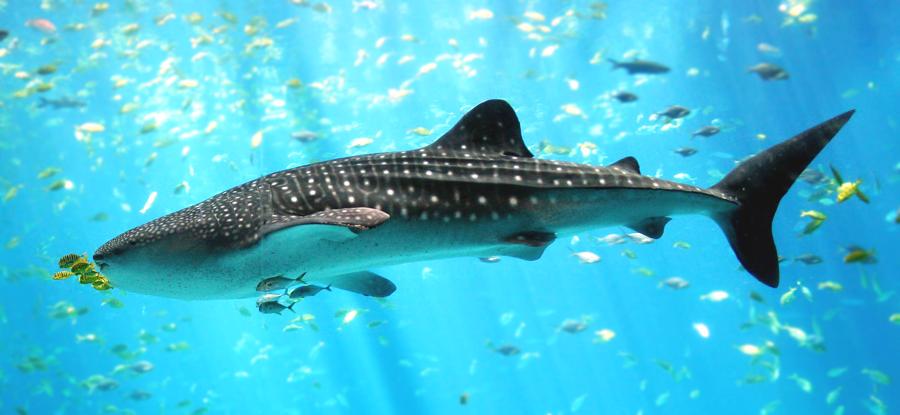About SSFP
About Us
Student Application
Subscribe to Our Newsletter
SSFP in the News
Members of Our Publishers Circle

Just off the Australian coast, in the Indian Ocean, tropical fish biologist Mark Meekan is looking for an animal that could be the world’s largest living omnivore. Meekan is from the Australian Institute of Marine Science in Perth, Australia, and he specializes in the study of whale sharks. After he spots one, he dives into the water with a hand spear and takes small samples of the shark's skin, which he uses to study characteristics like their diet. Although it sounds like these scientists are stabbing sharks with spears, they don’t hurt the sharks at all. In fact, they seem to like the attention.
Whale sharks (Rhincodon Typus) are the largest living fish species known to man, averaging about 12 meters in length. Not much is known about them because they reside deep in the ocean, but Meekan and scientists in his field are learning more.
Studying the skin tissues can reveal a lot about the animals’ biology and their behavior. Analyzing these samples, scientists found something unexpected: whale sharks are able to eat and digest algae. Whale sharks were long thought to be strict carnivores, but this new research suggests that they can also eat and digest plants. If these studies are true, this would make whale sharks the world’s largest living omnivores, putting the Kodiak brown bear in second place.
Whale sharks have always been found with algae in their digestive system. Taking into consideration that they open their mouths as wide as possible to capture as much plankton as they can, scientists just thought that it got caught in there by mistake. Typically, Carnivores can’t properly digest plants. Some scientists hypothesized that this plant life just passed through their internal organs without getting digested.
Meekan and his colleagues thought otherwise, and went to Ningaloo reef off the coast of Western Australia to find out. Each fall, a shiver of sharks gathers at that reef. The water camouflages the fish, making them hard to spot from close up. Instead, scientists use a helicopter to find these sharks. Once located, they speed off in a boat and dive immediately in the water upon arriving. They take pictures, tissue samples, and scrape off parasites.
Using these samples, scientists found high levels of arachidonic acid, an organic molecule found in a type of brown algae called sargassum. Whale sharks can’t produce this molecule themselves and scientists don’t know how it affects them. Most likely, they got it from digesting algae.Before all of this evidence in Australia, a similar group of researchers found plant nutrients in the skin of whale sharks in Japan, concluding that whale sharks commonly eat plants around the world.
Even after all of this evidence, it’s still hard to prove that these sharks eat algae on purpose. Robert Hueter, a shark biologist at Mote Marine Laboratory in Sarasota, Florida said, “Whale sharks take in a lot of other things than the food that they’re targeting, This is a bit like saying that cows are omnivores because they eat insects while feeding on grass.”
Meekan seems to agree with this statement. He can’t say for certain that whale sharks actively try to eat sargassum. But the truth is, they consume a lot of it.
It’s hard to say whether whale sharks are carnivores or omnivores. Whether or not algae is an intentional part of their diet, the animals can clearly digest them, Meekan says. “We don’t see whale sharks that often. But their tissues hold a remarkable record of what they’ve been up to,” he says. “We’re now learning how to read this library.”
[Sources: Science News Explores]
Loading Comments...